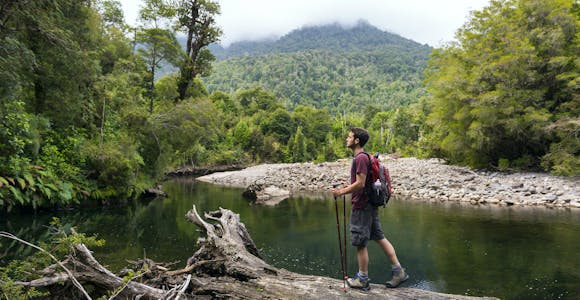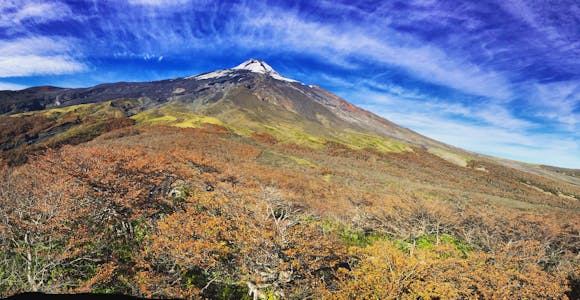
Vicente Pérez Rosales National Park
Snowy Osorno Volcano and the blue waters of Lake Todos los Santos usher visitors into one of the most accessible national parks in the Chilean Lake District.
Discover MoreDeep roots in Patagonia: We are ex-guides, tour leaders, outdoor enthusiasts, & adventurers.
We’ve got our feet on the ground: Impartial advice, a bespoke service, and at no extra cost.
For the ends of the Earth: Sustainability is more than our carbon footprint (but we’re reducing that too).

Hornopirén is one of the least visited parks on Chile’s famed Route of the Parks trail, but its attractions make it only more alluring for those who make the effort to get here. This is a land where rough trails make hikers feel like true pioneers, discovering thousand-year-old alerce trees in temperate rainforests, hidden lakes and waterfalls fed by vast fields of glaciers.

Yate volcano in Hornopirén National Park
Hornopirén National Park (Parque Nacional Hornopirén in Spanish) was established in 1988 and was incorporated into the Route of the Parks trail in 2018. Its name means ‘snow oven’ in the local Mapundungun language, in reference to the smoking peaks of Hornopirén Volcano that sits just outside the park’s northern boundary. The park covers the ancestral lands of the Huilliche, as well as the coastal Chono people who lived off the waters of the Comau fjord that forms the western limits of the park.
In total the park covers nearly 170,000 acres of particularly biodiverse landscapes of Chile’s Los Lagos province and has been declared part of the World Biosphere Reserve of the Austral Andes for its High Andean temperate rainforest and large numbers of endemic species The damp climate has produced a landscape particularly rich in the millenary alerce trees. This now endangered alpine hardwood can grow up to 60m in height and in the early colonial period was particularly heavily logged to make shingles for house. Hornopirén contains around 22,000 acres of intact alerce forest, along with many other tree species. At higher altitudes, the lenga beech predominates, until the tree line gives way to raw peaks. The higher slopes of the park are populated with glaciers that feed a multitude of rivers and three lakes: Pinto Concha, El Cabro and the remote but tantalisingly-named Lago Inexplorado.
25 species of mammal have been recorded in the park, including pumas and the pudu deer. For birdwatchers, it’s theoretically possible to tick off 123 species. Look in particular for the Magellanic woodpecker with its black body and red cap, the black-throated huet-huet and the chucao songbird.

Hornopirén National Park
If you really want to hike away from the crowds, then Hornopirén National Park is the place to head to. From the main park entrance there are a number of trails that head into the wilderness, but there are currently no formally established trekking circuits or refugios to stay in. The park’s wet climate means that you should dress for the possibility of rain; trails can get very muddy.
The best marked trail leads around 10km from the park entrance climbing up through forest to Lake Pinto Concha. A fit hiker can complete the hike in around 6–7 hours. As you ascend, you find yourself surrounded by alerce trees, until you emerge onto the lake’s wide beaches of grey volcanic sand. Camping is allowed in designated areas on the beach, and you’ll wake to stupendous views of the surrounding mountains.
Hiking a further 3km from Pinto Concha along gentle trails takes you through more alerce forest to a beautiful viewpoint on the southern slopes of Yates Volcano.
For those shorter on time, a simple day hike takes you along the lively waters of the Río Blanco river to its enchanting waterfall. The hike is around 90 minutes in each direction, with a stiff ascent on the final approach to the falls. There are two waterfalls, one above the other, feeding into a wide milky blue pool.
There are no refugios or lodges in Hornopirén National Park. There is a simple campsite at Laguna Pinto Concha, but camping is only permitted between December and March; outside these months no overnight stays in the park are allowed. It's best to base yourself in Puerto Varas to visit Hornopirén.
Access to the national park is through the small gateway town of Hornopirén (also sometimes known as Río Blanco). The park entrance is 17km northeast of the town along RN7. Irrespective of where you’re coming from either north or south, the peculiar geography of the Hornopirén area means that you’ll need to take a ferry as well as a vehicle to get there.
If you’re travelling from the heart of the Chilean Lake District, it takes around four hours to travel to Hornopirén from Puerto Montt (4½ hours if you're travelling from Puerto Varas), including the scenic 30 minute car ferry ride from La Arena to Puelche across the Reloncavi Sound. In high season, ferries depart at least once an hour.
From the south, there are ferries between Hornopirén and Caleta Gonzalo, the traditional northernmost starting point of the Carretera Austral highway as well as the gateway to Pumalín Douglas Tompkins National Park. The trip, known as the Ruta Bi-Modal, takes around five hours.

Snowy Osorno Volcano and the blue waters of Lake Todos los Santos usher visitors into one of the most accessible national parks in the Chilean Lake District.
Discover More
Alerce Andino is a temperate rainforest biosphere reserve dominated by ancient alerce trees that stands as the northern gateway to Chile’s epic Route of the Parks.
Discover More
The star power of three volcanoes is what draws visitors to Villarrica National Park on the doorstep of the outdoor sports capital of Pucón.
Discover More
Torres del Paine National Park, with its iconic granite Towers, is one of Patagonia's most popular destinations: a paradise for hikers and outdoor adventure activities.
Discover MoreIf you're looking for adventure, let us put together an itinerary made just for you.
This website uses cookies to ensure you get the best experience on our website. Privacy policy